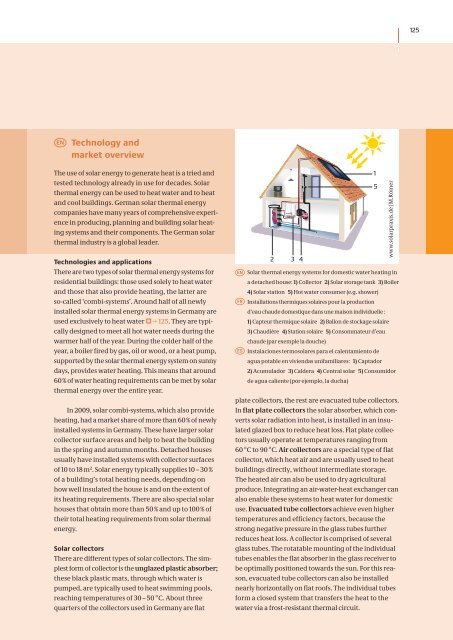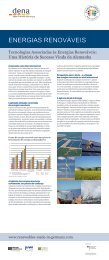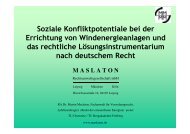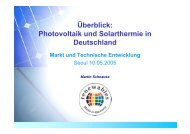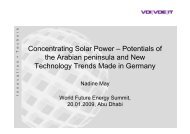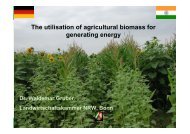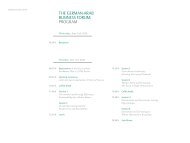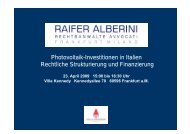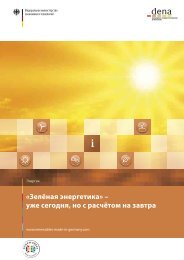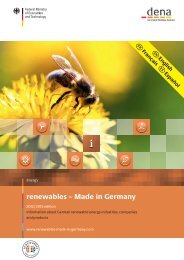renewables – Made in Germany
renewables – Made in Germany
renewables – Made in Germany
You also want an ePaper? Increase the reach of your titles
YUMPU automatically turns print PDFs into web optimized ePapers that Google loves.
g Technology and<br />
market overview<br />
The use of solar energy to generate heat is a tried and<br />
tested technology already <strong>in</strong> use for decades. Solar<br />
thermal energy can be used to heat water and to heat<br />
and cool build<strong>in</strong>gs. German solar thermal energy<br />
companies have many years of comprehensive experience<br />
<strong>in</strong> produc<strong>in</strong>g, plann<strong>in</strong>g and build<strong>in</strong>g solar heat<strong>in</strong>g<br />
systems and their components. The German solar<br />
thermal <strong>in</strong>dustry is a global leader.<br />
Technologies and applications<br />
There are two types of solar thermal energy systems for<br />
residential build<strong>in</strong>gs: those used solely to heat water<br />
and those that also provide heat<strong>in</strong>g, the latter are<br />
so-called ‘combi-systems’. Around half of all newly<br />
<strong>in</strong>stalled solar thermal energy systems <strong>in</strong> <strong>Germany</strong> are<br />
used exclusively to heat water �p 125. They are typically<br />
designed to meet all hot water needs dur<strong>in</strong>g the<br />
warmer half of the year. Dur<strong>in</strong>g the colder half of the<br />
year, a boiler fired by gas, oil or wood, or a heat pump,<br />
supported by the solar thermal energy system on sunny<br />
days, provides water heat<strong>in</strong>g. This means that around<br />
60 % of water heat<strong>in</strong>g requirements can be met by solar<br />
thermal energy over the entire year.<br />
In 2009, solar combi-systems, which also provide<br />
heat<strong>in</strong>g, had a market share of more than 60 % of newly<br />
<strong>in</strong>stalled systems <strong>in</strong> <strong>Germany</strong>. These have larger solar<br />
collector surface areas and help to heat the build<strong>in</strong>g<br />
<strong>in</strong> the spr<strong>in</strong>g and autumn months. Detached houses<br />
usually have <strong>in</strong>stalled systems with collector surfaces<br />
of 10 to 18 m 2 . Solar energy typically supplies 10 <strong>–</strong> 30 %<br />
of a build<strong>in</strong>g’s total heat<strong>in</strong>g needs, depend<strong>in</strong>g on<br />
how well <strong>in</strong>sulated the house is and on the extent of<br />
its heat<strong>in</strong>g requirements. There are also special solar<br />
houses that obta<strong>in</strong> more than 50 % and up to 100 % of<br />
their total heat<strong>in</strong>g requirements from solar thermal<br />
energy.<br />
Solar collectors<br />
There are different types of solar collectors. The simplest<br />
form of collector is the unglazed plastic absorber;<br />
these black plastic mats, through which water is<br />
pumped, are typically used to heat swimm<strong>in</strong>g pools,<br />
reach<strong>in</strong>g temperatures of 30 <strong>–</strong> 50 °C. About three<br />
quarters of the collectors used <strong>in</strong> <strong>Germany</strong> are flat<br />
2<br />
3<br />
4<br />
g Solar thermal energy systems for domestic water heat<strong>in</strong>g <strong>in</strong><br />
a detached house: 1) Collector 2) Solar storage tank 3) Boiler<br />
4) Solar station 5) Hot water consumer (e.g. shower)<br />
f Installations thermiques solaires pour la production<br />
d’eau chaude domestique dans une maison <strong>in</strong>dividuelle :<br />
1) Capteur thermique solaire 2) Ballon de stockage solaire<br />
3) Chaudière 4) Station solaire 5) Consommateur d’eau<br />
chaude (par exemple la douche)<br />
e Instalaciones termosolares para el calentamiento de<br />
agua potable en viviendas unifamiliares: 1) Captador<br />
2) Acumulador 3) Caldera 4) Central solar 5) Consumidor<br />
de agua caliente (por ejemplo, la ducha)<br />
plate collectors, the rest are evacuated tube collectors.<br />
In flat plate collectors the solar absorber, which converts<br />
solar radiation <strong>in</strong>to heat, is <strong>in</strong>stalled <strong>in</strong> an <strong>in</strong>sulated<br />
glazed box to reduce heat loss. Flat plate collectors<br />
usually operate at temperatures rang<strong>in</strong>g from<br />
60 °C to 90 °C. Air collectors are a special type of flat<br />
collector, which heat air and are usually used to heat<br />
build<strong>in</strong>gs directly, without <strong>in</strong>termediate storage.<br />
The heated air can also be used to dry agricultural<br />
produce. Integrat<strong>in</strong>g an air-water-heat exchanger can<br />
also enable these systems to heat water for domestic<br />
use. Evacuated tube collectors achieve even higher<br />
temperatures and efficiency factors, because the<br />
strong negative pressure <strong>in</strong> the glass tubes further<br />
reduces heat loss. A collector is comprised of several<br />
glass tubes. The rotatable mount<strong>in</strong>g of the <strong>in</strong>dividual<br />
tubes enables the flat absorber <strong>in</strong> the glass receiver to<br />
be optimally positioned towards the sun. For this reason,<br />
evacuated tube collectors can also be <strong>in</strong>stalled<br />
nearly horizontally on flat roofs. The <strong>in</strong>dividual tubes<br />
form a closed system that transfers the heat to the<br />
water via a frost-resistant thermal circuit.<br />
1<br />
5<br />
www.solarpraxis.de / M.Römer<br />
125


